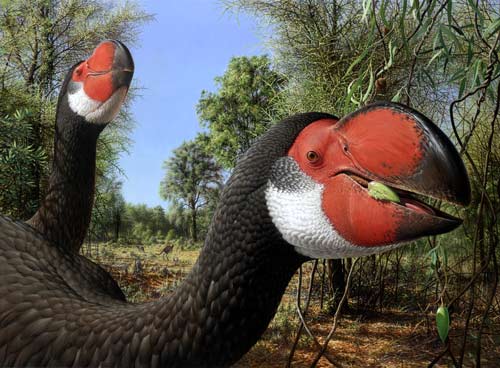I just primed four Bullockornis, one Megalania from Mick Yarrow... and one French Foreign Legion-er from Peter Pig :) Gonna start painting them tomorrow morning. These creatures were walking on ancient Australian soil during Neogene period.
From Wikipedia:
Bullockornis planei, nicknamed the Demon-Duck of Doom, is an extinct flightless bird that lived in the Middle Miocene, approximately 15 million years ago, in what is now Australia. Bullockornis stood approximately 2.5 metres (8 ft 2 in) tall. It may have weighed up to 250 kg (550 lb). Features of Bullockornis's skull, including a very large beak suited to shearing, indicate that the bird may have been carnivorous. The bird's skull is larger than that of many small horses.
Many paleontologists, including Peter Murray of the Central Australian Museum, believe that Bullockornis was related to geese and ducks. This, in addition to the bird's tremendous size and possible carnivorous habits, gave rise to its colourful nickname. The bird's generic name is improperly translated as "ox-bird", and was named instead for the type locality for the genus at Bullock Creek, Australia.
From Wikipedia:
The megalania (Megalania prisca or Varanus priscus) was a very large goanna or monitor lizard, now extinct. It was part of a megafaunal assemblage that inhabited southern Australia during the Pleistocene. It seems to have disappeared between 30,000 to 40,000 years ago. The first aboriginal settlers of Australia might have encountered living megalanias. Some Aboriginal Dreaming stories may even be about them.
Along with other varanid lizards, such as the Komodo dragon and the lace monitor, the megalania belongs to the proposed clade Toxicofera, which contains all known reptile clades possessing toxin-secreting oral glands, as well as their close, non-venomous relatives, including Iguania, Anguimorpha, and Serpentes. Thus, being a member of Anguimorpha, this makes megalania the largest venomous vertebrate known to have existed.




Fun stuff! I really like the trooper doing the Boogaloo! :0)> !!
ReplyDeleteHe is really terrified :)
DeleteNice sculpts!
ReplyDelete